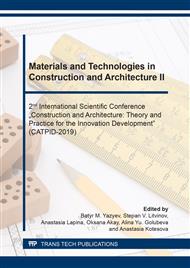[1]
I.I. Ovchinnikov, I.G. Ovchinnikov, G.V. Chesnokov, D.A. Tatiev, D.V. Pokulaev, The iron construction strengthening with the fiber reinforced plastic, Internet-journal Naukovedeniye. 3 (2014).
Google Scholar
[2]
A.R. Tusnin, E.O. Schurov, Experimental research of a glued joint in the construction elements made of steel and carbon plastic materials, Civil and Industrial engineering. 7 (2017) 69-73.
Google Scholar
[3]
A.R. Tusnin, E.O. Schurov, Experimental research of a glued joint in the construction elements made of steel and carbon plastic materials, Civil and Industrial engineering. 9 (2017) 25-29.
Google Scholar
[4]
A.I. Danilov, Concepts of managing the construction object demolishing, Civil and Industrial Engineerig. 8 (2014) 74-77.
Google Scholar
[5]
S. Tavakkolizadeh, H. Saadatmanesh, Fatigue strength of steel girders strengthened with carbon fiber reinforced polymer patch, Journal of Structural Engineering, ASCE. 129 (2003) 186-196.
DOI: 10.1061/(asce)0733-9445(2003)129:2(186)
Google Scholar
[6]
S. El-Tawil, E. Ekiz, S. Goel, S.-H. Chao, Retaining local and global buckling behavior of steel plastic hinges using CFRP, Journal of Constructional Steel Research. 67 (2011) 261-269.
DOI: 10.1016/j.jcsr.2010.11.007
Google Scholar
[7]
N. G. Tsouvalis, L. S. Mirisiotis, D. N. Dimou, Experimental and numerical study of the fatigue behaviour of composite patch reinforced cracked steel plates, International Journal of Fatigue. 31 (2009) 1613-1627.
DOI: 10.1016/j.ijfatigue.2009.04.006
Google Scholar
[8]
A. Shaat, D. Schnerch, A. Fam, S. Rizkalla, Retrofit of Steel Structures Using Fiber Reinforced Polymers (FRP): State-of-the-Art, Centre for Integration of Composites into Infrastructure. (2003).
Google Scholar
[9]
T.-C. Nguyen, Y. Bai, X.-L. Zhao, R. Al-Mahaidi, Mechanical characterization of steel/CFRP double strap joints at elevated temperatures. Composite Structures, 93, 1604-1612 (2011).
DOI: 10.1016/j.compstruct.2011.01.010
Google Scholar
[10]
M. Bocciarelli, P. Colombi, G. Fava and C. Poggi, Fatigue performance of tensile steel members strengthened with CFRP plates, Composite Structures. 87(2009) 334-343.
DOI: 10.1016/j.compstruct.2008.02.004
Google Scholar
[11]
H. Liu, R. Al-Mahaidi, and X. Zhao, Experimental study of fatigue crack growth behavior in adhesively reinforced steel structures, Compos. Struct. 90 (2009) 12-20.
DOI: 10.1016/j.compstruct.2009.02.016
Google Scholar
[12]
K. A. Harries, A. J. Peck, and E. J. Abraham, Enhancing stability of structural steel sections using FRP, Thin-Walled Structure. 47 (2009)1092-1101.
DOI: 10.1016/j.tws.2008.10.007
Google Scholar
[13]
A.K. Patnaik, and C. L. Bauer, Strengthening of steel beams with carbon FRP laminates, Proceeding of the 4th Advanced Composites for Bridges and structures conference, Calgary, Canada, (2004).
Google Scholar
[14]
P. Colombi, A. Bassetti, A. Nussbaumer, Analysis of cracked steel members reinforced by prestressed composite patch, Fatigue Fract Eng Mater Struct, 1(26) (2003) 59-67.
DOI: 10.1046/j.1460-2695.2003.00598.x
Google Scholar
[15]
B. Täljsten, C.S. Hansen, J.W. Schmidt, Strengthening of old metallic structures in fatigue with prestressed and non-prestressed CFRP laminates, Construction and Building Materials. 23(4) (2009) 1665-1677.
DOI: 10.1016/j.conbuildmat.2008.08.001
Google Scholar
[16]
E. Ghafoori, M. Motavalli, J. Botsis, A. Herwig, M. Galli, Fatigue strengthening of damaged metallic beams using prestressed unbonded and bonded CFRP plates, International Journal of Fatigue. 44 (2012) 303-315.
DOI: 10.1016/j.ijfatigue.2012.03.006
Google Scholar
[17]
E. Ghafoori, A. Schumacher, M. Motavalli, Fatigue behavior of notched steel beams reinforced with bonded CFRP plates: Determination of prestressing level for crack arrest, Engineering Structures. 45 (2012)270-283.
DOI: 10.1016/j.engstruct.2012.06.047
Google Scholar
[18]
E. Ghafoori, M. Motavalli, Flexural and interfacial behavior of metallic beams strengthened by prestressed bonded plates, Composite Structures. 101 (2013) 22-34.
DOI: 10.1016/j.compstruct.2013.01.021
Google Scholar
[19]
A.I. Danilov, O.A. Tusnina, Some Aspects of CFRP Steel Structures Reinforcement in Civil Engineering, Procedia Engineering. 153 (2016) 124–130.
DOI: 10.1016/j.proeng.2016.08.091
Google Scholar
[20]
A.I. Danilov, I.A. Kalugin, Analytical and finite element modeling in the calculation and design of reinforcements of stretched elements by fiber-reinforced polymers based on high-strength fiber using adhesive joints, Structural mechanics of engineering constructions and buildings. 14 (5) (2018) 414–426.
DOI: 10.22363/1815-5235-2018-14-5-414-426
Google Scholar


